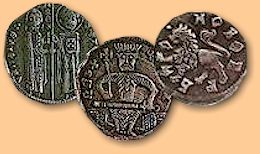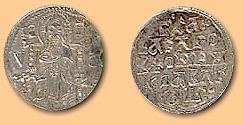In
those days medieval writers and historians paid more attention
to the life of the kings and noblemen than to the common people.
We know when the kings waged war, whom they married and, hmmm,
whom they divorced, but it is almost an impossible mission to
find out what an ordinary peasant had for his lunch.
Nowadays
we can make certain assumptions or try to find the facts by
studying old manuscripts, looking at the frescoes in the
monasteries etc.

The ring of Stefan I
It's
not easy to find out how ordinary people lived back in the
medieval Serbia because all written sources deal with the
rulers, battles and religious issues.
However,
we know that the noblemen had great control over the peasants
who worked on their land and had to give a part of their harvest
to their local duke and even had to work for a certain number of
weeks for their lords.
Serbia
was well developed country of the time and it had its own coins.
Starting from Uros I (1243-1276) the country had more than 800
different types of coins, which were used until the end of the
15th century.

Coins of (from left to
right): King Stefan I, Prince Lazar and Vuk Brankovic

Coins of the Mrnjavcevics
family
German's
miners came to Serbia in 1254 and they brought with them the
most advanced tools of the time. Novo Brdo's miners were going
190m deep into the ground and the highest European "record" back
than was 200m. They even knew for the acid which successfully
separated gold from silver. Serbian miners were highly respected
and they even were going to the south Italy to examine the
potential new mine facilities.
Serbian
royal court gave permission for the free practice of other
religions (mainly Catholic) but they were forbidden to convert
the dominant orthodox Christians into their faith. This is a
unique example because all over medieval Europe religious wars
were led. Stefan Nemanja welcomed German's Emperor Friedrich
Barbarossa on his way to Jerusalem during the Crusades. They
even signed a mutual declaration.
We don't
know for sure what they ate, but most probably meat and
vegetables were on the menu. While peasants could afford bread,
eggs, milk and cheese, noblemen enjoyed in game, fruits and
fish. Sugar wasn't used and it was substituted with honey. Red
wine was the favorite drink and it is mentioned many times in
Serbian folk songs.
Trade
was expanded and regulated by the Law. The Law of the Emperor
Dusan guaranteed complete freedom for the traders and protected
their interest from the greedy noblemen and thieves.
Art and
literature were the pleasure of the rich, although St. Sava tried to make it more available for the common people. Medieval
Serbia can be considered as a highly educated country and it
left numerous written documents and illuminated manuscripts.
Several printing presses were acquired and books were published
in the monasteries. Prince Stefan Lazarevic owned a huge library
and wrote several poems himself.

|
![]()